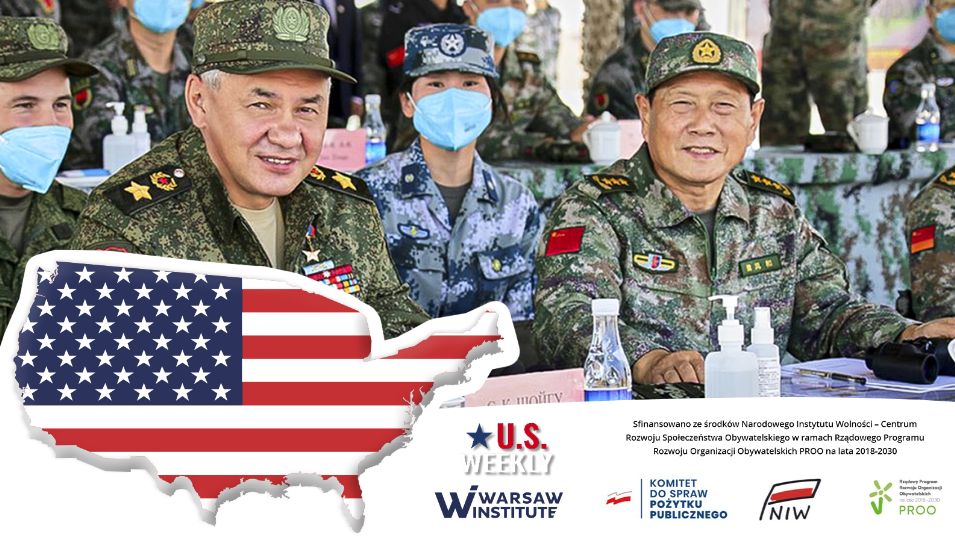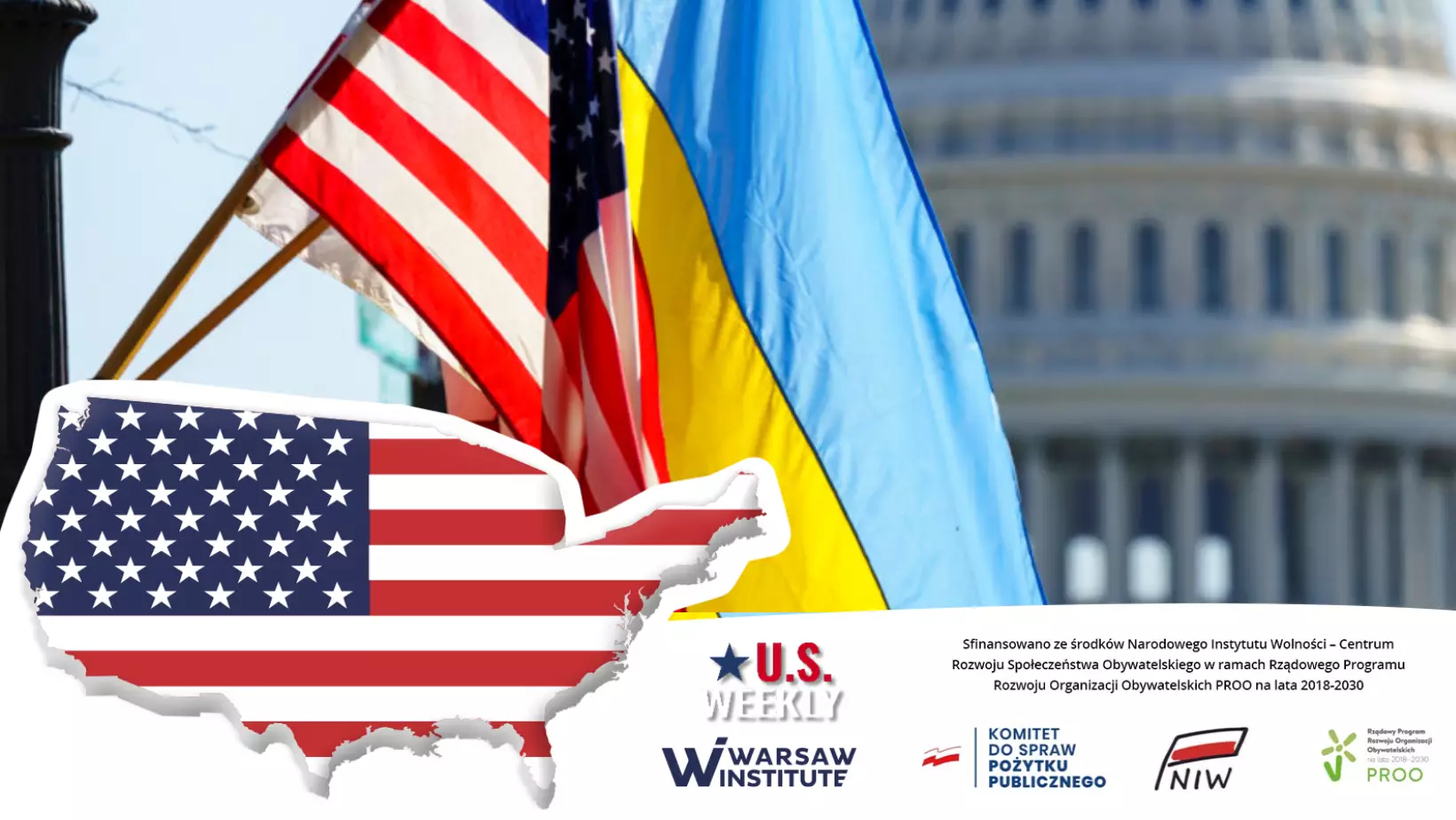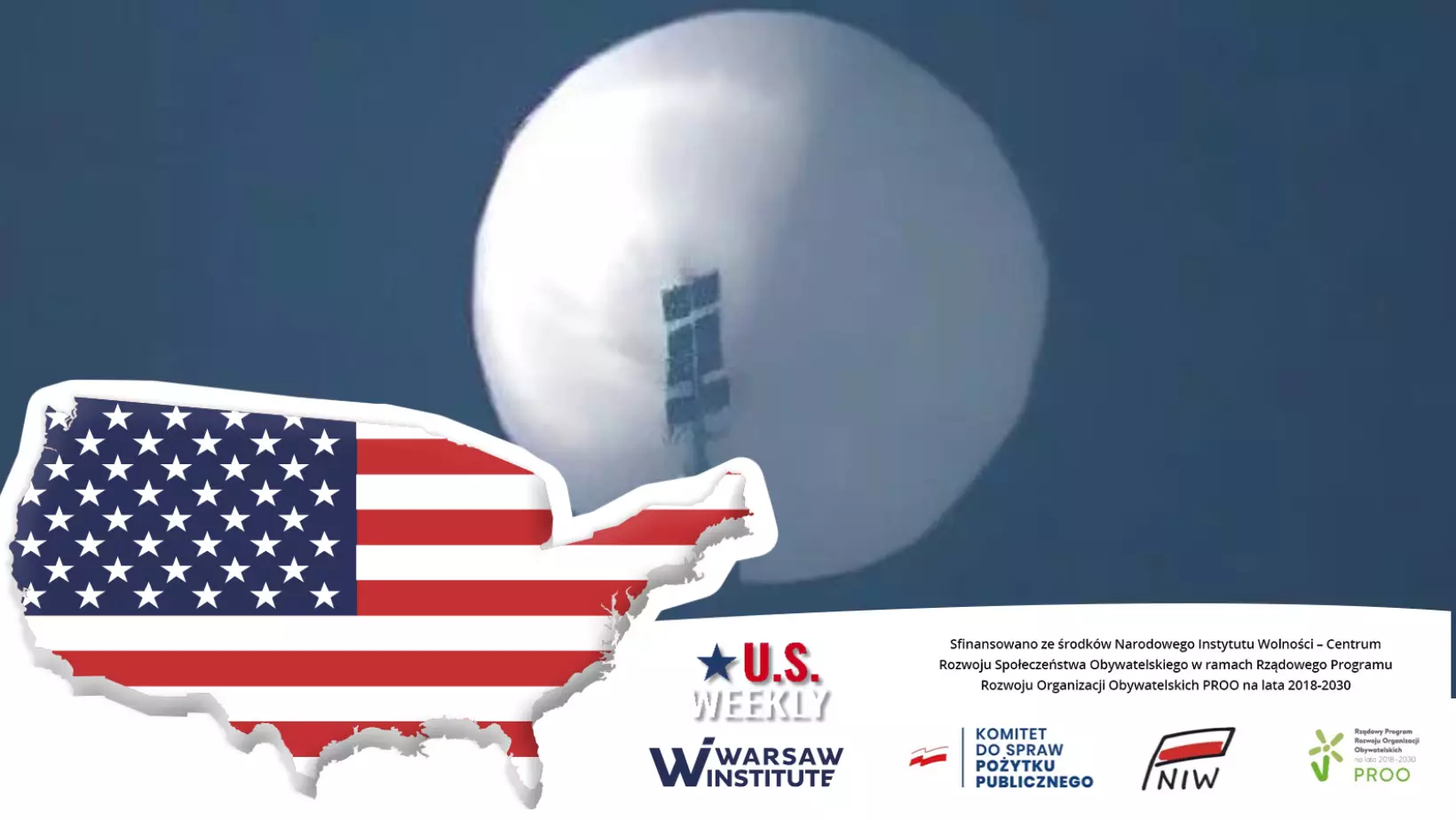
U.S. WEEKLY offers an in-depth analysis of various geopolitical processes that have direct effect on US’ domestic and foreign policies. This particular analytical column is possible thanks to the cooperation with polish media abroad: Dziennik Związkowy – Polish Daily News, Polishexpress of United Kingdom and WIrlandii.pl of Ireland
Date: 4 September 2023
Future Scenarios of Sino-Russian Military Cooperation
The post-Soviet monolithic international system, over which the United States unchallengedly has presided, is undergoing tectonic shifts engendered by the interplay of the American retreating influence from parts of the world and by the subsequent rise of aspiring global hegemons, regional powers or emboldened revisionists that seek to fill the vacuum left by the US in these parts of the world.

Observers concur that the American-led international order is changing but the outcome of this change is still unknown. Whilst some have already welcomed the era of multipolarity, others are more hesitant to declare it — noting that Washington’s prowess is still unmatched in every critical domain, thereby the transition from a unipolar world to a multipolar one is still in process. There are also those who draw parallels between the contemporary Sino-American antagonism and the Cold War U.S.-Soviet rivalry implying the emergence of a bipolar system with China and the United States vying for world hegemony and establishing their respective spheres of influence. A more sophisticated faction of the latter camp rejects the applications of Cold War mentalities to today’s China-United States competition emphasizing the economic interdependencies between the two contenders. Lastly, many scholars draw attention to the possibility of a catastrophic war probing whether this is inevitable or not. Either bipolar or multipolar, the world is entering a new phase and the Sino-Russian military ties will evolve according to the version of the international system that will eventually prevail. The behavior of the main actors in each of the potential future versions will also have a decisive impact on China-Russia military cooperation in the next decade.
1st Version – Bipolar world with China and the US in direct competition for influence and very limited, if at all, cooperation; the US hardens its stance toward both China and Russia:
In this version of acute bipolarity, China’s continuous rise has brought it within reach of the United States by every critical index, be it economic, military or technological. The U.S. feels threatened whereas Russia has been plunged into demise since the war in Ukraine losing its great power status in all but name. The United States reacts to China’s ascent by doubling down on its pressure. At the same time, the sanctions against Russia are still in place and Moscow is treated by the West as a pariah of the international system. Washington’s militant approach toward both China and Russia takes the form of military containment with NATO opening the doors of accession to the independent state of Ukraine and scaling up its arms build-up in Eastern Europe and the Indo-Pacific region. In the face of the American increased threat that is accompanied by inflammatory rhetoric against a new ‘axis of evil’, China and Russia intensify their military rapprochement expanding their defense cooperation. They start to conduct more frequent comprehensive military joint exercises with enhanced interoperability and in strategically sensitive parts of the world where they either have already organized drills, such as the Baltic Sea, the South China Sea, and the Mediterranean, or venture for the first time, such as the Arctic. The Sino-Russian military cooperation in space is also strengthened through extensive satellite-based data exchange and the signing of more tangible bilateral agreements that set the framework and specify the timeframe of the joint establishment of facilities and exploration on the moon. In the domain of sensitive technologies, Russia and China increase the number of joint air defense exercises, while the defense industrial cooperation of the two partners in submarine quieting and theater hypersonic weapons further tightens. A potential deal between Russia and China within the context of their greater military cooperation is the supply of a Russian RD-180 rocket engine in exchange for Chinese space-grade microelectronic components. Russia’s technological provisions catalyze China’s already growing development bringing it to parity with the United States. The amplifying power asymmetry between Moscow and Beijing causes occasional frictions within their military partnership, reminiscent of those between France and the U.S. within NATO in the 1960s, but, as France, Russia temporarily acquiesces to juniors partner status due to security concerns that necessitate its sticking to China to counter what they both perceive as American threat. In this scenario of all-around strategic competition between the United States on one side and China and Russia on the other, a great power war is not out of the question. Even in the event of a China-U.S. or Russia-NATO war, however, the Sino-Russian strategic partnership is not likely to turn into a full-blown military alliance unless the United States strikes ‘pre-emptively’ against the country that is not a party to the conflict lest the latter assist the opponent or attempt to capitalize upon the distraction of Washington by scoring geopolitical gains amid the war.
2nd Version – Bipolar world with China and the US in direct competition for influence and very limited, if at all, cooperation; the US tries to ease tensions with Russia:
The United States maximizes the pressure on China fighting for maintaining its global supremacy. Estimating that parallel tensions with Russia divert its attention away from the main rival who is the only one able to challenge it economically and militarily, Washington decides to mend its relations with Moscow. Western sanctions on Russia are fully or partly lifted, while NATO provides guarantees for the non-deployment of missiles or troops in Russia’s periphery. The Russo-American rapprochement puts the growth of the Sino-Russian military partnership at stake. Moscow’s economy begins to recover after the lifting of the sanctions but Russia is still considerably weaker than before. The absence of a pressing threat from the United States affords Moscow greater flexibility in its relations with China, which now has to be more mindful of treating Russia as an equal despite the steep power asymmetry between them. If China acts as a patron dictating to Russia what foreign policy objectives it may or may not pursue, Moscow will be reluctant to further upgrade their defense cooperation as mistrust will re-surface. Russia will play China and the U.S. off each other in a bid to emerge as a powerful third pole. The Sino-Russian military ties will continue to exist but joint exercises and cooperation in sensitive technologies will probably be terminated. On the other hand, if China accommodates Russia’s calls for an equal partnership the defense cooperation between the two countries will continue to be strong, but the likelihood of Moscow pursuing further reinforcement of the Sino-Russian military ties, with the American threat out of the picture, is rather dim.
3rd Version – Bipolar world with China and the US cooperating in various areas, including environment, space, and trade. Russia tries to balance within this Sino-American rapprochement:
This version, which defies the mainstream concept of ‘Thucydides trap’, places the two most powerful state actors in the international system next to each other rather than against each other. Taken from the books of the most optimistic neo-liberals, this scenario plays out as the United States and China team up to tackle global challenges, such as climate change, maximize their wealth through regional and bilateral trade with low tariff regulations and minimum commerce restraints, and assure the peaceful use of space as an area of global patrimony and not as a new battleground for strong states’ games of influence. Similarly to the previous version, the easing of the tensions between the United States and China has an adverse effect on the Sino-Russian security ties. China’s recently acquired military self-sufficiency and technological superiority over Russia, paired with the decrease of the threat posed by the United States, removes the incentives for Beijing to pursue a stronger military relationship with Moscow. Within the spirit of the Sino-American rapprochement, China ceases to conduct joint exercises with Russia, still at odds with the West, that are deemed ‘provocative’ by Washington and refrains from cooperating with Moscow in missile technology and other sensitive areas, such as space technologies, in order to not raise suspicions within the Pentagon. The thawing of Sino-American relations is in China’s interest since it is able to resume its economic growth undistracted while promoting its interests in East Asia without significant backlash from Washington. The Sino-Russian military ties are limited, and in some areas such as military exercises, non-existent.
4th Version – Multipolar world with Russia, China, and the US balancing and competing with each other:
In a multipolar international system, more than two actors have the ability to influence the behavior of others and the outcomes of global crises. In the version of multipolarity, China, the United States, and Russia, as well as other actors such as India, Brazil, or even a coherent European Union, constitute unique centers of power that are relatively equal. Washington is still the most powerful actor but this time presiding over a group of other major powers that can check it and, if united, counterbalance it. In a multipolar world, the Sino-Russian military partnership serves as a bulwark to the United States’ influence but the extent to which it deepens hinges on Washington’s handling of the new geopolitical reality wherein it is no longer the sole pole around which the world revolves. If Washington reacts spasmodically to the inevitable redistribution of power that is taking place denying adjusting, the Sino-Russian military relations will evolve and extend to include ad hoc partnerships with other major powers to balance the United States. The final product of American reactionism will be the formation of a firm ant-U.S. block whose most prominent members will be powerful enough to directly challenge Washington. If the United States embraces multipolarity and delegates some of its global responsibilities that it is currently undertaking on its own, the other great powers in the system will not feel the need to rally against it. The Sino-Russian military ties will then have to adapt to a new era in which China and Russia are relatively equally strong global actors who cooperate and compete with each other according to each particular circumstance that exists in the region of their interest. In that case, their military partnership is unlikely to expand to cooperation in sensitive technologies, as both will be careful to avoid giving an edge to the other, but it will certainly maintain its strategic role with joint military exercises, cyber space cooperation, and mutual weapons sales continuing on a regular basis. One element that will work in favor of the resumption of the Sino-Russian partnership will be the parity between China and Russia. They will know that conflict between them will have grave consequences on both making cooperation a more sensible approach than intensive antagonism. Both being considerably influential will also mean that neither will feel inferior within the partnership and mutual respect of each other’s interests will not have to be enforced. Finally, the Sino-Russian military ties within a multipolar international order accepted by the United States will be re-directed toward other potential adversaries that could pose a threat to Moscow’s and Beijing’s interests. This diversification of attention to more than one of the competitors will provide more incentives for the deepening of the Russia-China defense cooperation.
Author:
Vasilis Petropoulos is an international relations analyst based in Washington DC. He has a Master’s degree in Law and Diplomacy from the Fletcher School at Tufts University in Boston, with a specialization in international security and great power competition in Eurasia. He is a published author of several articles on international relations both in English and Greek.
Editor:
Katja-Elisabeth Herrmann Katja-Elisabeth works as a research fellow at the Warsaw Institute. She graduated with an MA in Transatlantic Affairs from the College of Europe (Warsaw, Poland) and the Fletcher School of Law and Diplomacy at Tufts University, cross-registering as a student at the Harvard Kennedy School of Government (Boston, MA). Additionally, Katja-Elisabeth holds a BA in International Relations and International Organizations, which she combined with a degree in International and European Law (LLB) from the University of Groningen.
Her research is mainly devoted to transatlantic security and defense topics, particularly emerging and disruptive technologies. She was recently awarded the Squire Patton Boggs Foundation public policy fellowship in 2022 to conduct research on U.S. domestic politics and the Three Seas Initiative. She is also interested in cybersecurity and crisis management.
She recently presented her research at the Fletcher School on semiconductor technologies’ political and industrial landscape in the U.S. and the EU. She will continue her research, focusing on the challenges and opportunities for military procurement for NATO allies.
Sources:
1. Berger Eric, ‘Russia Now Looking to Sell Its Prized Rocket Engines to China’, Ars Technica, January 2018
2. Gorenburg Dmitry, ‘An Emerging Strategic Partnership: Trends in Russia-China Military Cooperation’, Security Insights, George C. Marshall European Center for Security Studies, No. 54, April 2020
3. Kwon Jaebeom, Sung Hoon Jeh, Kihyun Lee, ‘Dragon and bear dancing waltz under the sharp-clawed eagle: three critical junctures, aggravating threat perceptions, and evolving strategic ties between China and Russia’, Japanese Journal of Political Science (146-166), No.23, April 2022
4. Lukin Artyom, ‘The Russia-China entente and its future’, International Politics (363-380), No. 58, June 2020
Support Us
If content prepared by Warsaw Institute team is useful for you, please support our actions. Donations from private persons are necessary for the continuation of our mission.
All texts published by the Warsaw Institute Foundation may be disseminated on the condition that their origin is credited. Images may not be used without permission.

















